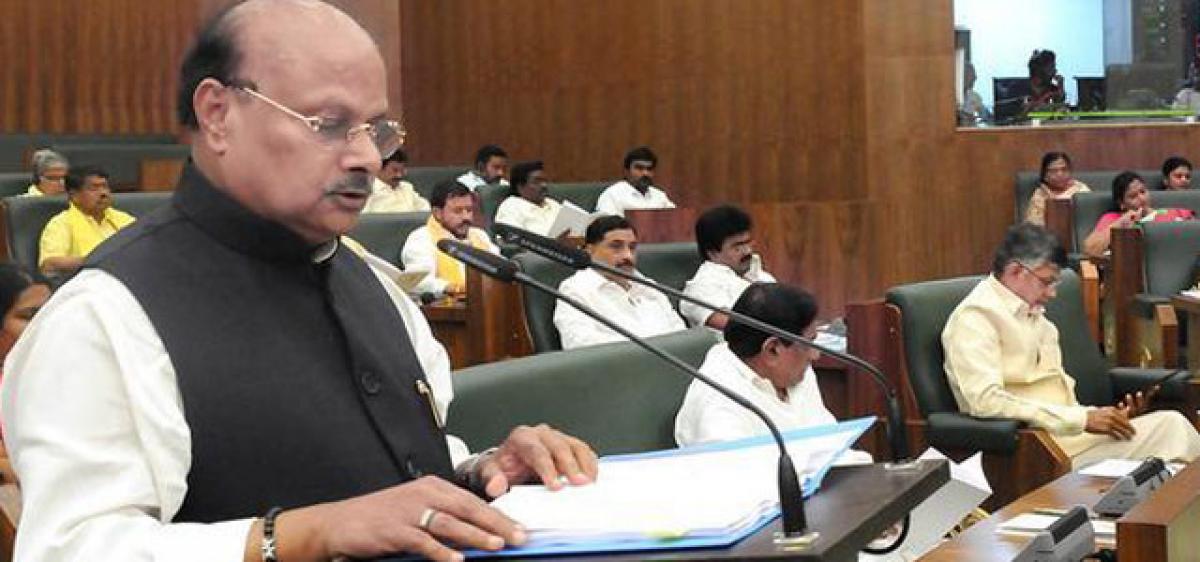Live
- They always want me to win, and now I feel lucky to have been offered a story like ‘Zebra’: Satyadev Kancharana
- ‘Democracy first, humanity first’: PM Modi in Guyana's parliament on two countries' similarities
- PKL Season 11: Telugu Titans register third straight win to top standings
- Is Pollution Contributing to Your COPD?
- NASA Unveils Underwater Robots for Exploring Jupiter's Moons
- Additional Central forces arrive in violence-hit Manipur
- AR Rahman and Saira Banu’s Divorce: Legal Insights into Common Issues in Bollywood Marriages
- 82.7 pc work completed in HPCL Rajasthan Refinery area: official
- Curfew relaxation extended in 5 Manipur districts on Friday
- Tab scam prompts Bengal govt to adopt caution over fund disbursement
Just In

Rising subsidies and mounting public debts appear to be the twin disturbing features of AP’s economy post bifurcation. The budget for 2017-18 presented by Finance Minister Yanamala Ramakrishnudu in the Assembly a few days ago reveals that the outstanding public debt is projected at Rs 1.25 lakh crore during the fiscal. It includes Rs 73,856 crore which the truncated state has inherited as its shar
Experts in the field of public finance who spoke to this writer did not differ on the FM’s `largesse’ in favour of subsidies and welfare measures. But they unanimously emphasised the need to tame the growing fiscal deficit which is projected at Rs 23,000 crore by way of avoiding mistargeting of the spending on welfare schemes. Fiscal deficit to GSDP ratio has exceeded 3% limit to reach the 3.5 per cent mark
Rising subsidies and mounting public debts appear to be the twin disturbing features of AP’s economy post bifurcation. The budget for 2017-18 presented by Finance Minister Yanamala Ramakrishnudu in the Assembly a few days ago reveals that the outstanding public debt is projected at Rs 1.25 lakh crore during the fiscal. It includes Rs 73,856 crore which the truncated state has inherited as its share in the total debts of Rs 1.26 lakh crore in the undivided state.
The subsidy and welfare outgoes under social sector spending take away 35,651 crore (22.7%) out of the total budget outlay of Rs 1.57 lakh crores. A sum of Rs 9,700 crore is proposed to be set apart for debt relief to farmers (Rs 3,600 crore), power subsidy/servicing of bonds (3,300 crore) and rice subsidy (Rs 2,800 crore) under the subsidy head while an allocation of Rs 25,981 crore is made for welfare schemes such as Scheduled Castes component, tribal component, BC component, welfare of Kapu corporation, welfare of economically backward castes, minorities and welfare of Brahmin community.
Experts in the field of public finance who spoke to this writer did not differ on the FM’s `largesse’ in favour of subsidies and welfare measures. But they unanimously emphasised the need to tame the growing fiscal deficit which is projected at Rs 23,000 crore by way of avoiding mistargeting of the spending on welfare schemes.
A Ranga Reddy, a retired professor in Economics from SV University, said the spending on welfare and subsidy cannot be questioned as building of human capital is the need of the hour. At the same time, there is a need to check the “broker economy” which is responsible for failing the welfare economy to ameliorate the conditions of the people under the below poverty line (BPL), he said.
The manner in which the welfare programmes are getting implemented at present are only ensuring “middlemen welfare,” Reddy commented. As a matter of coincidence, Chief Minister N Chandrababu Naidu at a media conference soon after the inaugural of the joint session of the Assembly by Governor ESL Narasimhan too stated that the rice scheme is covering around 92 per cent of the population in the state, a clear indication for mistargeting of the scheme.
CSN Raju, an expert in public finance, highlighted the need to improve fiscal discipline by plugging loopholes in spending on subsidies and welfare programmes. Fiscal deficit in ratio of gross state domestic product (GSDP) has reached the 3.5 per cent mark, exceeding the limit of 3 per cent enforced by the Finance Commission under the Fiscal Responsibility and Budget Management Act (FRBMA).
Yanamala has been requesting the Union Finance Ministry time and again to relax the limit up to 3.5 per cent for AP by treating the latter as a `special case’ so as to enable the state government to raise more debts to carry forward its welfare-development agendas on an equal footing.
Prof Raju said Yanamala was in a bind over presenting a populist budget two years ahead of the general elections with political compulsions. LSN Prasad, an economist, pointed out that Yanamala’s budget heavily tilted more towards revenue expenditure than the capital expenditure, which is not a healthy sign.
“For instance, the FM proposed to spend Rs 18,343 crore under the revenue account while leaving only Rs 1,222 crore for spending under the capital account under the head of rural development with an outlay of Rs 1,965 crore,” Prasad said. He observed a similar trend in energy sector also.
It is proposed to facilitate an outgo of Rs 42.74 crore under the revenue account and only Rs 537 crore under capital account, he added. The truncated AP cannot be equated with the other states in terms of toeing fiscal discipline since it is yet to recover from the bruises inflicted by the bifurcation, asserts FM.
Yanamala’s feat failed to escape the trend of identity politics sweeping across the state during the current TDP regime. Allocation of Rs 1,000 crore for Kapu Corporation, proposal to create most backward classes (MBC) corporation and setting apart a huge chunk of Rs 10,000 crore under the BC component indicate this fact.

© 2024 Hyderabad Media House Limited/The Hans India. All rights reserved. Powered by hocalwire.com







